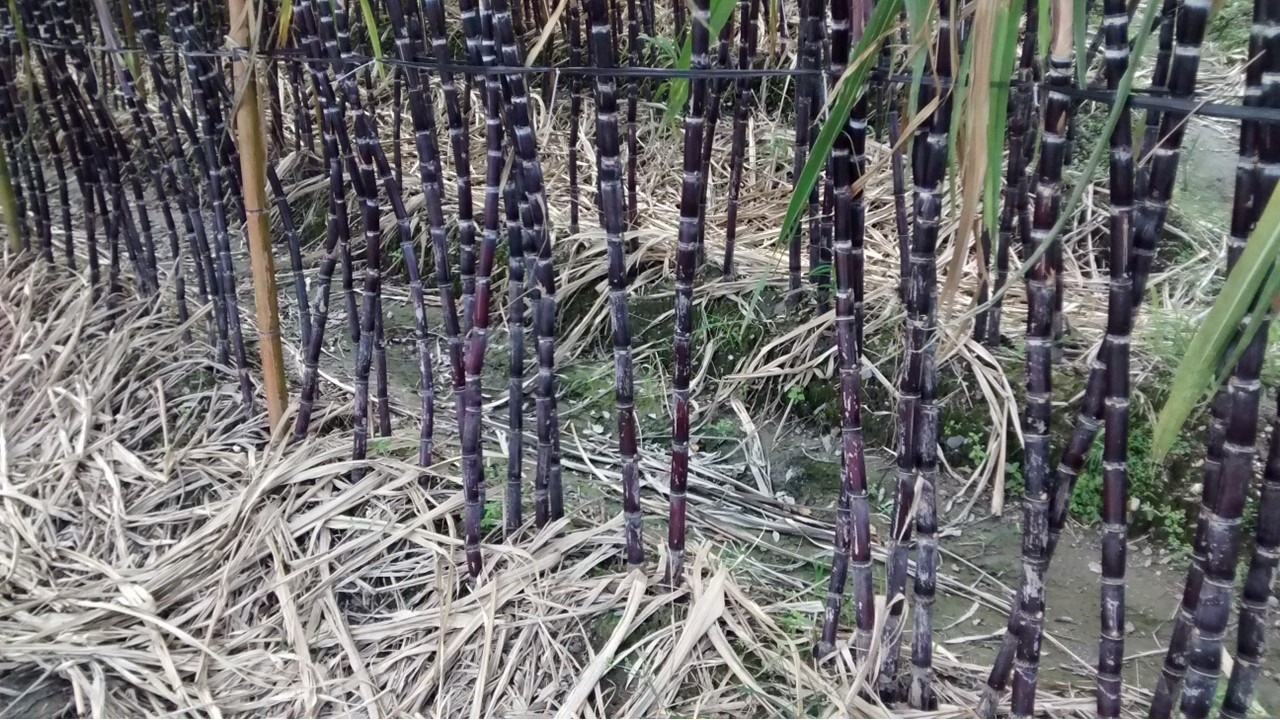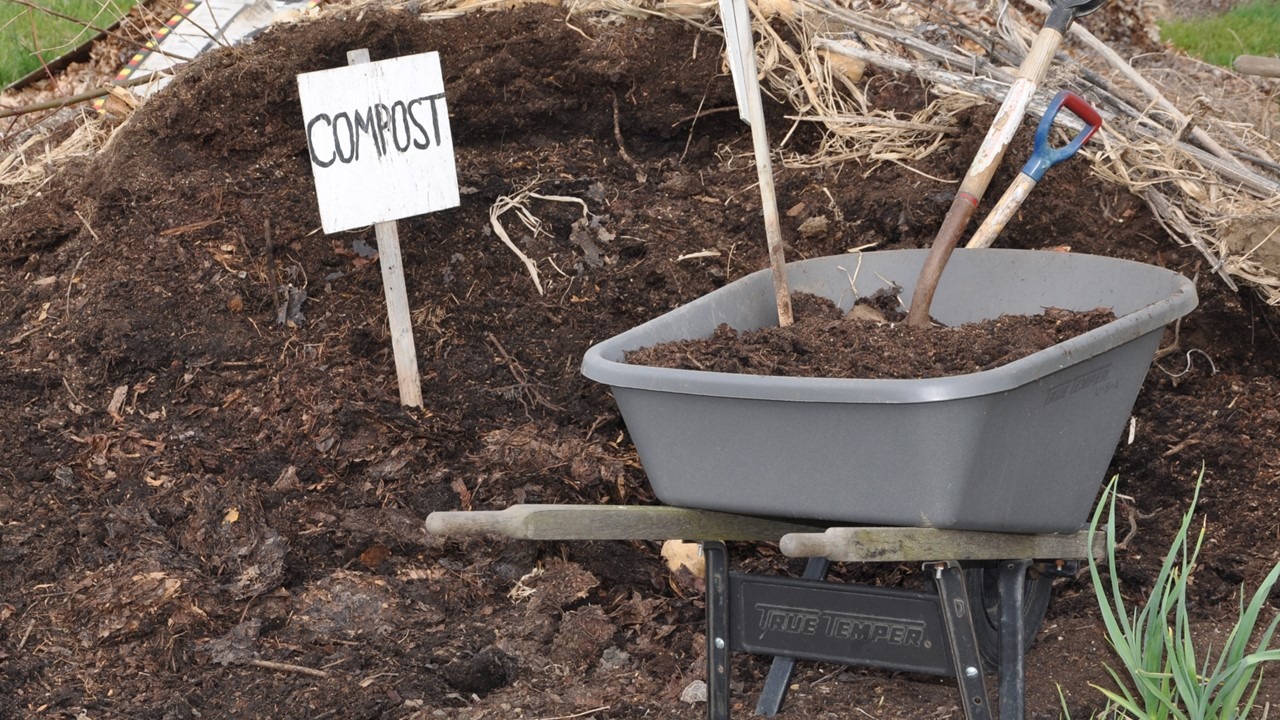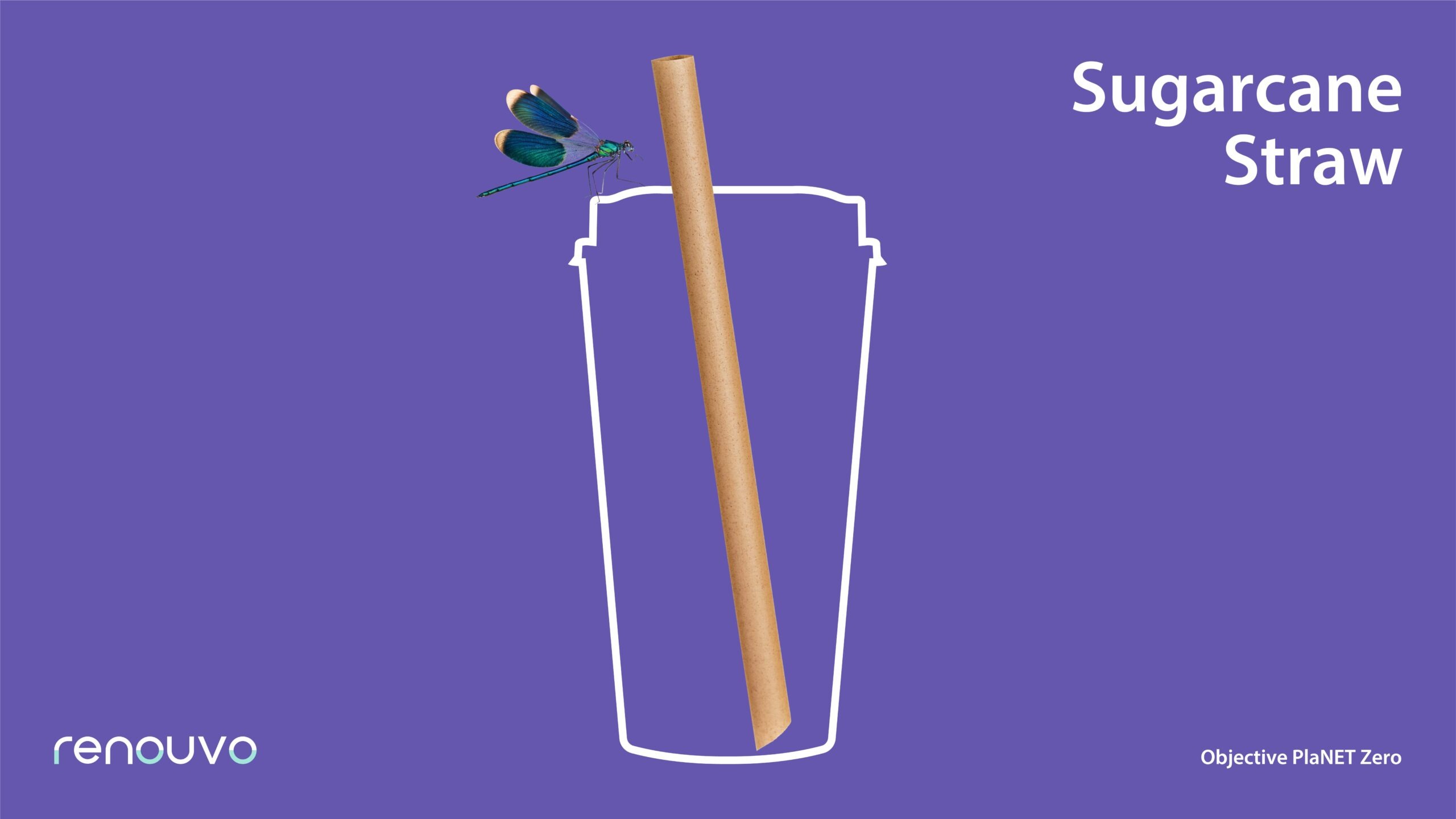In recent years, due to the gradual depletion of resources and serious environmental problems, people have proposed the Zero Waste philosophy, hoping to minimize unprocessed waste through collaboration between various units. The Zero Waste solution is a way to implement Zero Waste proposed by the government, organizations, corporations, or individuals. Understand and implement Zero Waste solutions to strive towards the goal of Zero Waste and creating a sustainable, eco-friendly lifestyle.
What is Zero Waste?
Zero Waste is the vision and goal of resource sustainability. Currently, the most recognized peer-reviewed definition of Zero Waste was published by the Zero Waste International Alliance (ZWIA), which states “The conservation of all resources by means of responsible production, consumption, reuse, and recovery of products, packaging, and materials without burning and with no discharges to land, water, or air that threaten the environment or human health.”
To achieve Zero Waste, people have come up with the concept of the Zero Waste Hierarchy from the principle of 3R (Reuse, Reduce, Recycle), which divides the waste disposal methods into pyramid-like levels according to their level of burden on the environment. For a more detailed definition and level of Zero Waste, please read the article What is Zero Waste? Zero Waste principles and examples. Here we refer to the value hill proposed by Elisa Achterberg et al., with some modifications made as illustrated below:
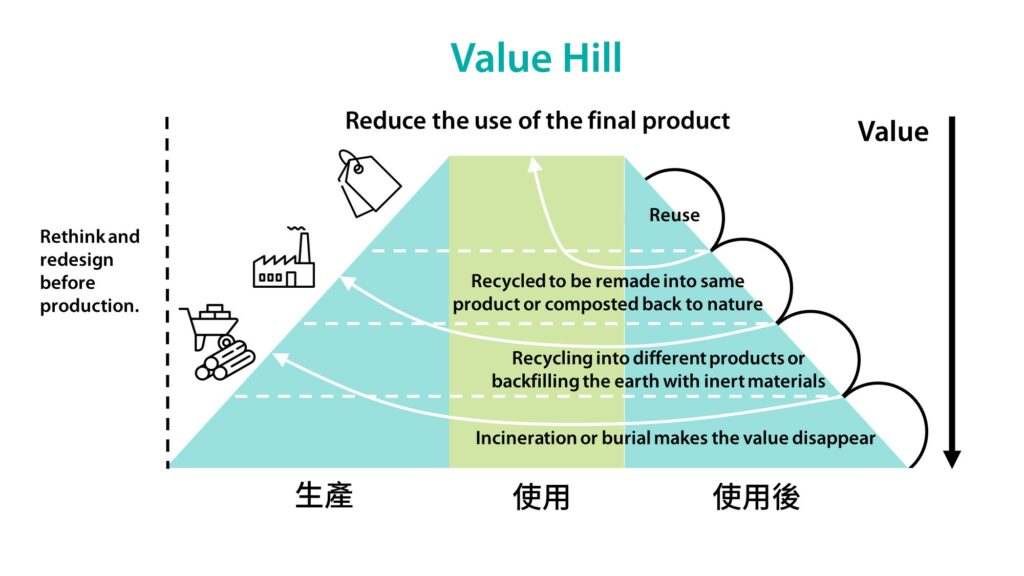
People hope to retain the products’ value on the value hill, and Zero Waste represents the various means indicated on the mountainside, trying to retain the added value throughout the production process to maximize resource utilization.
What are Zero Waste solutions?
Based on the directions provided by the Zero Waste Hierarchy, people have devised numerous Zero Waste solutions. By implementing these Zero Waste solutions, the one-way flow of resources to landfills or incinerators can be prevented, in turn creating a sustainable production and consumption model. Three examples of Zero Waste solutions are listed below:
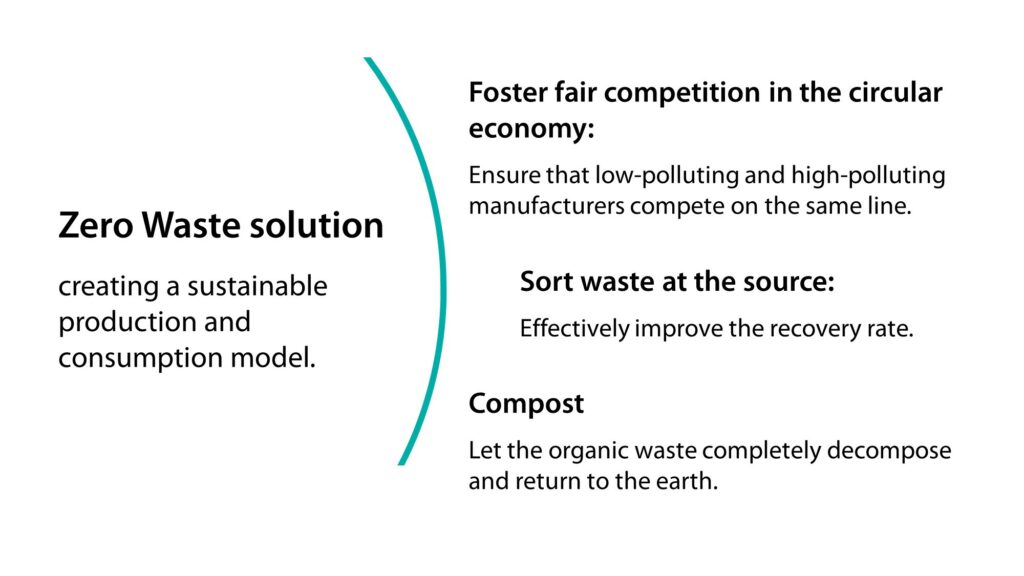
- Foster fair competition in the circular economy
The production cost of manufacturers adopting a linear economy model may seem inexpensive, but in fact, their environmental and social costs are hidden. This is an enormous disadvantage for manufacturers that do not transfer their costs externally or strive to offer positive benefits. To realize truly fair competition, the government has reified the environmental and social benefits generated by various corporations, levying additional taxes on manufacturers that create negative externalities or terminating subsidies, while at the same time subsidizing manufacturers that have implemented Zero Waste.
- Sort waste at the source
Disposing of different kinds of waste requires different kinds of equipment. Even if a product adopts a recyclable design, if different kinds of waste are mixed during the recycling process and contaminate each other, it will increase the difficulty of recycling and decrease the recycling rate. Consequently, the government needs to establish various independent waste recycling systems, which are usually divided into four categories: organic substances, paper, recyclables (metal, plastic, glass), and other residues. The product user should sort waste according to regulations to ensure resources are recycled effectively.
- Compost
Composting is the perfect way to dispose of organic substances, allowing them to break down completely and return to the environment. Industrial composting facilities are equipped with larger and more sophisticated equipment capable of processing municipal waste or agricultural waste. Households can also compost at home to reduce the amount of organic waste processed by municipal systems.
For more information on composting and comparisons with industrial composting and household composting, please read: HOME COMPOSTING VS INDUSTRIAL COMPOSTING HOW THEY WORKS.
How to start Zero Waste solutions and services
Zero Waste is receiving increasing attention everywhere, and the value of Zero Waste solutions and services is gradually on the rise. Corporations can look for areas in the value hill that will serve their functions and maintain the value of resources by reviewing their expertise, to provide Zero Waste services to other corporations or consumers. The following is an example involving a corporation launching Zero Waste solutions and services through the various stages of the value hill:
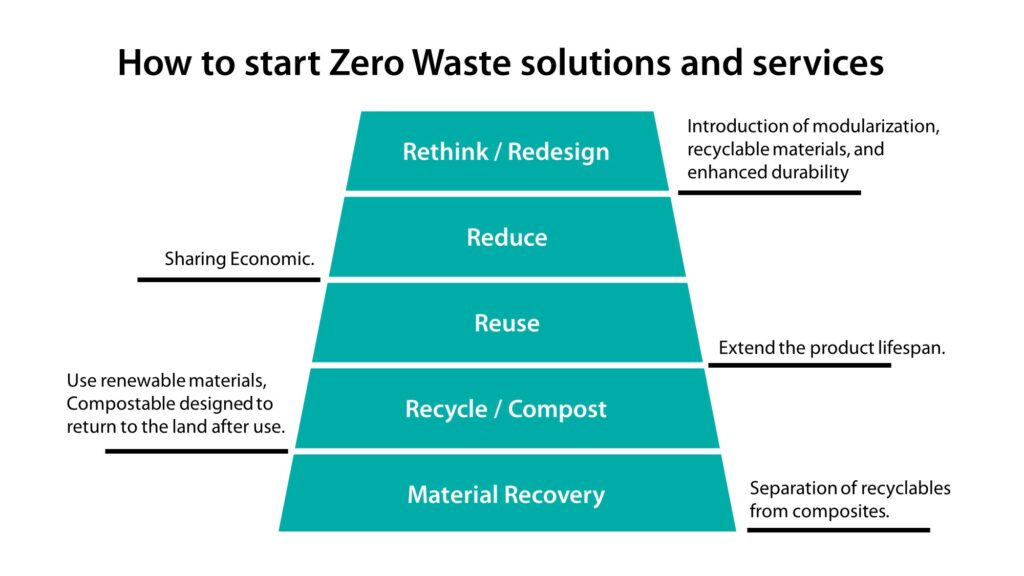
Rethink/Redesign
At this stage, it is hoped that the product design will be more in line with the concept of Zero Waste through the introduction of modularization, recyclable materials, and enhanced durability before production. Corporations can provide product design services or apply this concept to manufacture products. For example, the modular design of Fairphone cell phones allows consumers to replace batteries, cameras, charging ports, screens, and other components by themselves. Furthermore, the phone uses recycled plastic as its main material.
Reduce
Sharing is one of the Zero Waste solutions for reducing product usage. For example, people who have less need for cars can enjoy the convenience of cars by renting one from a car rental company without purchasing a car, thereby reducing the need for private car ownership. Manufacturers can provide eco-friendly cup and lunch box rental services at activities, which can be cleaned and used for the next event, making it a viable business model.
Reuse
Servicing is the best Zero Waste solution for product reuse, where the product lifespan is extended to achieve the goal of reuse. The concept is embodied in the aftersales service of the product. For example, a cell phone that offers a five-year service and software update warranty. A second-hand product trading platform is also a Zero Waste solution for reuse.
Recycle/Compost
With the trend of Zero Waste taking the world by storm, many companies are beginning to use renewable materials during production, causing the price of renewable plastics and paper to increase. Enterprises can focus on the R&D of recycling technologies for recyclable materials such as glass, metal, and plastic, creating low-energy and high-efficiency Zero Waste solutions and services. For instance, Taiwan’s Spring Pool Glass boasts a powerful recycling technology to endow recycled and remanufactured glass products with higher value by combining product design.
Composting is the best way to dispose of organic waste. Besides industrial composting facilities, creating home composting barrels and selling worms are all business models for supporting home composting. Moreover, one can also produce or provide compostable products that allow users to dispose of them via composting so they can return to the environment. For instance, restaurants can purchase compostable straws for consumers to replace plastic straws.
Material Recovery
Separating recyclable materials from composite products that cannot be remanufactured and turning them into other products for various purposes is known as material recycling. Examples include recycling metals from circuit boards, or chemically repolymerizing plastics into different materials.
Build an eco-friendly lifestyle with Zero Waste solutions
Individuals can select from a variety of Zero Waste solutions provided by enterprises to start their eco-friendly lifestyles. Three different examples of Zero Waste solutions are given below based on the 3R principle of reduce, reuse, and recycle:

-
Reduce: Use a reusable cup-share system
To reduce the use of disposable cups, manufacturers have joined forces with local governments to launch the reusable cup-share system, where consumers purchasing made-to-order beverages at supermarkets or coffee shops can make use of reusable cups for a small deposit. After they have finished the beverage, they can return the cups to various recycling stations to collect their deposit. The approach effectively decreases the number of unrecyclable paper cups with plastic coating and plastic cups used.
-
Reuse: Choose products with a warranty
Many home appliance and furniture manufacturers offer warranty. For instance, LG’s washing machines carry a ten-year maintenance warranty, and IKEA also provides a ten-year warranty for sofas and cabinets, thereby ensuring that the product can be repaired and reused within the warranty period. Also, Apple phones offer software updates for five to six years after purchase compared to the two to three years provided by other phone manufacturers. This is also a Zero Waste solution that facilitates the sustainable use of products.
-
Recycle: Sort and recycle recyclable products properly after use
Avoid using unrecyclable disposable products such as plastic straws. If using disposable products is unavoidable, choose compostable products. After using recyclable products such as plastic bottles and aluminum cans, place them in separate waste bins to be disposed of by suitable waste disposal firms.
Ten Zero Waste products
Ugly fruits and vegetables
According to the UN’s statistics, 14% of food produced globally is wasted between harvest and retail. Due to their unappealing appearance, retailers tend to discard these ugly fruits and vegetables directly when they are just as edible as ordinary fruits and vegetables. Now, retailers are beginning to collect these ugly fruits and vegetables and sell them at a discount to prevent waste, making them a Zero Waste product.
Second-hand clothes
Garments may be discarded due to personal problems such as preference or size, hence there is a vast second-hand clothes market. Buying and wearing second-hand clothes prevents more clothes from being produced—the vast majority of clothes are not recyclable and compostable because they are produced with a mixture of composite materials including cotton, linen, and plastic.
Home compost bins
Not every region has industrial composting facilities, thus not all domestic organic waste is disposed of via composting. As a result, organic waste that could have been decomposed is sent to landfills and remains there for several decades. Meanwhile, the waste will release harmful wastewater and the greenhouse gas methane. Home compost bins help households to compost at home using food scraps, coffee filters, cardboard boxes, and home compostable products without relying on industrial composting facilities, thereby saving the cost of transporting waste to an industrial facility.
Compostable straws
In the past, people used hundreds of millions of plastic straws every day. Due to their lightweight and small size, they are difficult to recycle and frequently end up in the environment, ranking them among the top 10 types of litter most commonly found on beaches. Compostable straws can be placed in compost bins after use, where they are returned to the environment via industrial or home composting.
Paper-wrapped soap
Personal hygiene products such as shampoo and shower gel are often packaged in plastic bottles for convenience, and the chemicals used in these products may contaminate the water resource system. Since soap is made from a soap base, if no other chemicals such as fragrance or foaming agents are added, it can break down naturally. At the same time, if the soap is packaged in ordinary paper during the transportation process, it can be recycled.
Eco-friendly stainless steel tableware
Eco-friendly tableware made of stainless steel is safe and durable and can be used thousands of times if washed correctly. Bring your stainless steel tableware whether you are eating out or enjoying takeout at home to minimize the use of disposable tableware. If the stainless steel tableware becomes obsolete, it can be recycled and recast into other products.
Modular cell phones
Every component of the cell phone is crucial to its functionality. If the camera, screen, battery, charging port, or any part of the mainboard malfunctions, the cell phone will not continue to function normally. Modern cell phones are not easy to disassemble, thus servicing or replacing any faulty part will require the phone to be sent to a service center, costing a lot of time and money. There is also a chance that the phone cannot be repaired because it is no longer in production. Modular cell phones have separate components that are sold for several years after the product is launched, allowing users to purchase new components and replace them at home to prolong the lifespan of the phone.
Burlap sacks
Woven from hemp, burlap sacks are mostly used as shopping bags or bags for holding coffee beans or grains. They are reusable and, if no chemical dyes or plastics are used during the manufacturing process, burlap sacks can decompose naturally like plants. Worn out burlap sacks can be buried around the roots of transplanted plants to provide good drainage and aeration.
Eco-friendly cups
It is imperative to stay hydrated when going out for more than a few hours. Carrying an eco-friendly cup with you will minimize the need for stores to provide disposable paper cups or plastic cups, or you can obtain water from a water dispenser. Since cups are consumables, it is advised to use recyclable stainless steel water bottles, silicone bottles, or compostable eco-friendly cups to ensure that they can be disposed of properly.
Handkerchiefs
We often use toilet paper or facial tissues without thinking to wipe off sweat, clean our hands, or blow our nose. These toilet paper and facial tissues are wrapped in plastic, and they themselves are also unrecyclable, hence a significant amount of waste can be accumulated over time. Bringing handkerchiefs with you can reduce the consumption of toilet paper or facial tissues. If the handkerchief is made of pure cotton, it can be composted and returned to the soil once it is worn out.
For more zero waste solutions, please see this article: 2023 ZERO WASTE LIFESTYLE: 20 WAYS TO LIVE A ZERO WASTE LIFE.
Is Zero Waste a solution to climate change?
Besides affecting our living environment and causing resource depletion, waste will also accelerate the speed of climate change due to the extraction of more resources such as minerals, oil, and timber. Using resources properly to achieve the goal of Zero Waste can also solve the problem of climate change from the source in a bid to create a sustainable environment in the future.











